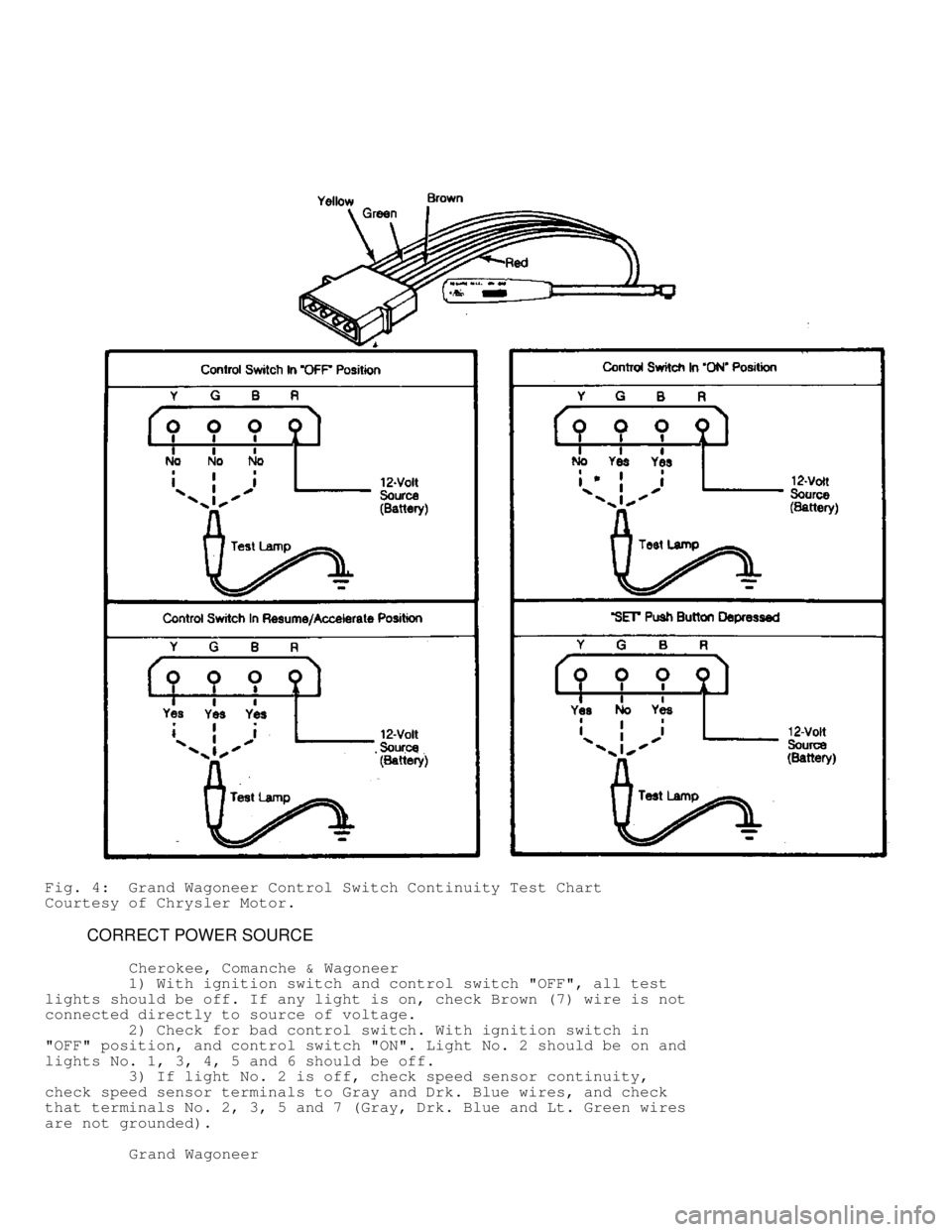1988 JEEP CHEROKEE sensor
[x] Cancel search: sensorPage 351 of 1378

SYSTEM WILL NOT ENGAGE
Restricted vacuum hose or no vacuum. Control switch or
control module defective. Speed sensor defective. Clutch or brake
light switch defective or misadjusted. Brake light switch wire
disconnected. Open circuit between brake light switch and brake
lights.
RESUME FEATURE INOPERATIVE
Defective servo ground connection. Defective control switch.
ACCELERATE FUNCTION INOPERATIVE
Accelerate circuit in control module inoperative. Defective
control switch.
SYSTEM RE-ENGAGES WHEN BRAKE PEDAL IS RELEASED
Defective control module. Mechanical vent valve not opening.
Kink in mechanical vent valve hose. Brake light switch defective.
CARBURETOR THROTTLE DOES NOT RETURN TO IDLE POSITION
Improper linkage adjustment.
ROAD SPEED CHANGES 2 MPH OR MORE WHEN SETTING SPEED
Centering adjustment wrong. Servo link misadjusted.
ENGINE ACCELERATES WHEN STARTED
Improper servo chain adjustment. Vacuum hose connections
reversed at servo. Defective servo.
SYSTEM DISENGAGES ON LEVEL ROAD WITHOUT APPLYING BRAKES
Loose wire connection. Loose vacuum hose connection. Servo
linkage broken. Defective brake light switch.
ERRATIC OPERATION
Reverse polarity of system wiring. Defective servo. Defective
control module.
VEHICLE CONTINUES TO ACCELERATE WHEN "SET" BUTTON IS RELEASED
Servo or control module defective.
SYSTEM ENGAGES BUT SLOWLY LOSES SET SPEED
Air leak at connections or in vacuum hoses. Air leak on vent
valve on brake pedal.
ADJUSTMENTS
CONTROL MODULE ADJUSTMENT
NOTE: Control module adjustments are preset by manufacturer. If
other components in system appear to be functioning properly
Page 353 of 1378

control module before starting diagnosis or repair procedure, as this
connection is disturbed when Cruise Command System Tester (AM PC-1-R)
is used. Poor connection at this point may be improperly diagnosed as
control module malfunction.
Brake light and clutch switches should be properly adjusted.
Ensure that all vacuum lines are correctly routed and tightly
connected.
CRUISE COMMAND SYSTEM TESTS
Testing is performed with Cruise Command System Tester (AM
PC-1-R). Remove wire harness connector from control module. Connect
tester to wire harness connector. Perform tests as part of service
diagnosis to determine cause and correction of system malfunction.
Various tester lights are associated with specific components,
circuits, etc.
CONTROL SWITCH CONTINUITY
Wrangler
NOTE: Voltage checks should show battery voltage. If resistance
readings are incorrect, check circuit for an open or a
short. Cruise control module terminal No. 1 grounds through
connector at engine block.
Light No. 1 "OFF" (Set Switch)
With control switch in "ON" position, check for battery
voltage between HAZ/STOP and in-line fuse, terminal No. 14 and ground
terminal No. 1
Light No. 2 "OFF" (Control Switch & Speed Sensor)
With control switch in "ON" position, check for battery
voltage between HAZ/STOP and in-line fuse, terminal No. 5 and ground
terminal No. 1. With ignition switch in "OFF" position, check
resistance between terminals No. 2 and No. 3. Resistance should be 15-
50 ohms.
Light No. 3 "OFF" (Brake Light Ground)
With ignition switch in "ON" position, install jumper wire
between terminals No. 7 and No. 13. If brake lights do not turn on,
check fuses and brake light switch connections.
Light No. 4 "OFF" (Throttle Position Feedback Sensor)
With ignition switch in "ON" position, check for battery
voltage between gauge fuses at terminals No. 7 and No. 1.
With ignition switch in "OFF" position, check resistance
between terminals No. 2 and No. 11. Resistance should be 2400-4000
ohms. At idle resistance should be 2800-4300 ohms and at wide open
throttle resistance should be 4000 ohms.
Light No. 5 "OFF" (Resume/Accel/Vent Valve)
With control switch in "RESUME/ACCEL" position, check for
battery voltage between HAZ/STOP and in-line fuse, terminal No. 10 and
ground terminal No. 1. With ignition switch in "OFF" position, check
resistance between terminals No. 6 and No. 12. Resistance should be
30-50 ohms. Resistance between terminals No. 6 and ground, and
terminal No. 12 and ground should be infinite (open).
Light No. 6 "OFF" (Resume/Accel/Charge Valve)
With control switch in "RESUME/ACCEL" position, check for
battery voltage between HAZ/STOP and in-line fuse, terminal No. 10 and
ground terminal No. 1. With ignition switch in "OFF" position, check
resistance between terminals No. 4 and No. 12. Resistance should be
Page 355 of 1378

Fig. 4: Grand Wagoneer Control Switch Continuity Test Chart
Courtesy of Chrysler Motor.
CORRECT POWER SOURCE
Cherokee, Comanche & Wagoneer
1) With ignition switch and control switch "OFF", all test
lights should be off. If any light is on, check Brown (7) wire is not
connected directly to source of voltage.
2) Check for bad control switch. With ignition switch in
"OFF" position, and control switch "ON". Light No. 2 should be on and
lights No. 1, 3, 4, 5 and 6 should be off.
3) If light No. 2 is off, check speed sensor continuity,
check speed sensor terminals to Gray and Drk. Blue wires, and check
that terminals No. 2, 3, 5 and 7 (Gray, Drk. Blue and Lt. Green wires
are not grounded).
Grand Wagoneer
Page 356 of 1378

With ignition and control switches in "OFF" position, test
lights should be off. If one or more lights are on, remove Brown (5)
wire at control module connector and check for direct source of
voltage or repair defective control switch.
SYSTEM ELECTRICAL CONTINUITY
Cherokee, Comanche & Wagoneer
1) With ignition and control switches in "ON" position,
lights No. 2, 3 and 4 should be on. Lights No. 1, 5 and 6 should be
off. If light No. 2 is off, check speed sensor continuity, check speed
sensor terminals to Gray and Drk. Blue wires, and check terminals No.
2, 3, 5 and 7 (Gray, Drk. Blue and Lt. Green wires are not grounded).
2) If light No. 3 is off, check brake light switch and all
Brown, Lt. Blue and Lt. Green wire connections. If light No. 4 is off,
check terminals No. 2 and No. 11 at control module connector. Check
continuity of throttle position feedback rheostat of servo.
Grand Wagoneer
1) With ignition and control switches in "ON" position,
lights No. 1, 2, 3, and 4 should be on. Lights No. 5 and 6 should be
off. If light No. 1 is off, check for blown fuse in brake light switch
to control switch circuit. Check Red, Brown and Green wires at control
switch for continuity to switch. Check Drk. Green wire (14) at control\
module connector for continuity to control module.
2) If light No. 2 is off, check speed sensor for correct
output voltage. Check Gray and Drk. Blue wire at speed sensor
connector for continuity to control module connector. Check terminals
No. 2, 3, 5 and 7 at control module connector for proper connection to
wires.
3) If light No. 3 is off, check brake and clutch switch
adjustment. If light No. 4 is off, check for defective connection at
terminals No. 2 and 11 on control module connector. Check operation of
throttle position feedback rheostat on servo.
COAST CONTINUITY TEST
Cherokee, Comanche & Wagoneer
1) With ignition and control switches in "ON" position,
depress and hold "SET/COAST" button. Lights No. 1, 2, 3 and 4 should
be on. Lights No. 5 and 6 should be off. If light No. 1 is off, check
voltage from brake light switch, check 4-amp in-line fuse of Pink
wire, and check Pink, Brown and Drk. Green wires at control switch
connector and Drk. Green (14) wire at control module connector for
good connections.
2) If light No. 2 is off, check speed sensor continuity,
check speed sensor terminals to Gray and Drk. Blue wires, and check
terminals No. 2, 3, 5 and 7 (Gray, Drk. Blue and Lt. Green wires) for
ground.
3) If light No. 3 is off, check brake light switch, check all
Brown, Lt. Blue and Lt. Green wire connections. If light No. 4 is off,
check terminals No. 2 and 11 at control module connector, and check
continuity of throttle position feedback rheostat of servo.
SERVO CHARGE VALVE SOLENOID CONTINUITY
CAUTION: If engine is running, servo will move throttle to wide open
position.
Grand Wagoneer
1) With ignition and control switches in "ON" position,
depress and hold "SET/COAST" button. Lights No. 2, 3, 4, 5 and 6
should be on. Light No. 1 should be off. Light No. 4 will dim when
Page 357 of 1378

servo moves throttle to wide open position with engine operating.
2) If light No. 2 is off, check speed sensor for correct
output voltage. Check Gray and Drk. Blue wire at speed sensor
connector for continuity to control module connector. Check terminals
No. 2, 3, 5 and 7 at control module connector for proper connection to
wires.
3) If light No. 3 is off, check brake and clutch switch
adjustment. If light No. 4 is off, check for defective connection at
terminals No. 2 and 11 on control module connector. Check operation of
throttle position feedback rheostat on servo.
4) If light No. 5 is off, check for defective connections at
terminals No. 4 and 12 on control module connector. If necessary,
replace defective servo. If light No. 6 is off, check for defective
connection at terminals No. 6 and 12 on control module connector. If
necessary, replace defective servo.
5) If all lights are off after depressing set/coast speed
switch, check for blown fuse. Check for short circuits in Red, Pink
and Brown wire circuits at control switch. If necessary, replace
defective servo.
SYSTEM DISENGAGEMENT WITH BRAKE PEDAL DEPRESSED
Cherokee, Comanche & Wagoneer
1) With ignition and control switches in "ON" position and
brake pedal depressed, lights No. 2 and 4 should be on. Lights No. 1,
3, 5 and 6 should be off. Light No. 3 should be on when brake pedal is
released.
2) If light No. 2 is off, check speed sensor continuity,
check speed sensor terminals to Gray and Drk. Blue wires, and check
terminals No. 2, 3, 5 and 7 (Gray, Drk. Blue and Lt. Green) for
ground.
3) If light No. 4 is off, check terminals No. 2 and 11 at
control module connector, and check continuity of throttle position
feedback rheostat of servo.
Grand Wagoneer
1) With ignition and control switches in "ON" position and
brake pedal depressed, lights No. 1, 2 and 4 should be on. Lights No.
3, 5 and 6 should be off. Light No. 3 should be on when brake pedal is
released.
2) If light No. 1 is off, check for blown fuse in brake light
switch to control switch circuit. Check Red, Brown and Green wires at
control switch connector for continuity to switch. Check Drk. Green
wire (14) at control module connector for continuity to control
module.
3) If light No. 2 is off, check speed sensor for correct
output voltage. Check Gray and Drk. Blue wire at speed sensor
connector for continuity to control module connector. Check terminals
No. 2, 3, 5 and 7 at control module connector for proper connection to
wires.
4) If light No. 4 is off, check for defective connection at
terminals No. 2 and 11 on control module connector. Check operation of
throttle position feedback rheostat on servo. If light No. 3 is off
when brake pedal is released, check brake light switch adjustment.
"RESUME/ACCEL" FUNCTION
CAUTION: If engine is running, servo will move throttle to wide open
position.
Cherokee, Comanche & Wagoneer
1) With ignition and control switches in "ON" position, slide
and hold control switch in "R/A" position. Lights No. 2, 3, 4, 5 and 6
Page 358 of 1378

should be on. Light No. 1 should be off. Light No. 4 will dim when
servo moves throttle to wide open position, if engine is running.
2) If light No. 2 is off, check speed sensor terminal
connections to control module through Gray and Drk. Blue wires. Check
terminals No. 2, 3, 5 and 7 (Gray, Drk. Blue and Lt. Green wires) for
ground.
3) If light No. 3 is off, check brake light switch, and check
all Brown, Lt. Blue and Lt. Green wire connections. If light No. 4 is
off, check terminals No. 2 and 11 at control module connector. Check
continuity of throttle position feedback rheostat of servo.
4) If light No. 5 is off, check for bad connection at White
(6) and Orange (12) wire terminals. If necessary, replace defective
servo.
5) If all lights are off after moving control switch to "R/A"
position, check for blown fuse or fuses, and check Red, Pink, Brown or
White wires for shorts. If necessary replace defective servo.
Grand Wagoneer
1) With ignition and control switches in "ON" position, slide
control switch to "R/A" position. All test lights should be on. Light
No. 4 will dim when servo moves throttle to wide open position, if
engine is running.
2) If light No. 1 is off, check for blown fuse in brake light
switch to control switch circuit. Check Red, Brown and Green wires at
control switch for continuity to switch.
3) If light No. 2 is off, check Gray and Drk. Blue wire at
speed sensor connector for continuity to control module connector.
4) If light No. 3 is off, check brake light switch
adjustment. If light No. 4 is off, check for defective connection at
terminals No. 2 and 11 on control module connector. Check operation of
throttle position feedback rheostat on servo.
5) If light No. 5 is off, check for defective connections at
terminals No. 4 and 12 on control module connector. If necessary,
replace defective servo. If light No. 6 is off, check for defective
connection at terminals No. 6 and 12 on control module connector. If
necessary, replace defective servo.
6) If all lights are off after moving control switch to "R/A"
position, check for blown fuse. Check for short circuits in Red, Pink
and Brown wire circuits at control switch. If necessary, replace
defective servo.
SPEED SENSOR TEST
1) Disconnect wire harness connector at speed sensor. Connect
a voltmeter (set on low AC scale) to terminals from speed sensor.
2) Raise front and rear wheels of vehicle off ground and
support vehicle with safety stands. Run engine (wheels spinning
freely) at 30 MPH and note voltage.
3) Voltage should be approximately .9 volts. Increases of .1
volts per each 10 MPH increase in speed should also be noticed. Turn
off engine and stop wheels. Lower vehicle. Connect speed sensor wire
harness.
SERVO TEST
1) With ignition switch in "OFF" position, disconnect servo
wire harness connector. Remove vacuum hose from brake pedal vent valve
nipple on servo. Disconnect servo cable from throttle linkage at
carburetor.
2) Connect an ohmmeter between ground and Red. Ground and
Orange. And Ground and White wire terminals of servo wire harness
connector. See Fig. 5. Observe ohmmeter during each test. An infinite
(open circuit) resistance should be indicated for each wire terminal.
Page 436 of 1378

FLANGES
FLEX PLATES
FLUID LEVEL INDICATORS
FLUIDS AND LUBRICANTS
FLYWHEELS
FORCE MOTORS
GUIDES
HALF SHAFTS
HOSES, LINES AND TUBES
HOUSINGS (BELL, CASE, TAIL (EXTENSION) AND AUXILIARY)
INTERMEDIATE SHAFT SUPPORT BEARINGS
KEY INTERLOCK SYSTEMS
LIMITED SLIPS
LINES
LINKAGES (EXTERNAL)
LOCKING HUB ASSEMBLIES
LOCKING HUB CONTROL KNOBS
LUBRICANTS
METAL-CLAD SEALS
METALASTIC JOINTS
MODULATOR PINS
MODULATORS
MOUNTS (ENGINE, TRANSAXLE AND TRANSMISSION)
ODOMETER DRIVES (MECHANICAL)
ODOMETER HEADS (MECHANICAL)
OIL PANS
PANS
PILOT HOLES
PRESSURE PLATES
PRESSURE SWITCHES
RACES
RUBBER JOINTS (METALASTIC)
SCREENS
SEALS
SEALS (METAL-CLAD)
SELECTOR INTERLOCK SYSTEMS
SERVOS
SHIFT INTERLOCK SYSTEMS (SELECTOR AND KEY INTERLOCK SYSTEMS)
SENSORS
SIDE COVERS
SLIP YOKES
SOLENOIDS
SPEED SENSORS (ELECTRONIC WHEEL AND VEHICLE)
SPEEDOMETER-DRIVEN GEAR HOUSINGS
SPEEDOMETER/ODOMETER DRIVES (MECHANICAL)
SPEEDOMETER/ODOMETER HEADS (MECHANICAL)
SPEEDOMETERS AND ODOMETERS (ELECTRONIC)
SWITCHES
TONE WHEELS
TOOTHED RINGS (TONE WHEELS)
TORQUE CONVERTERS
TRANSAXLE MOUNTS
TRANSDUCERS (TRANSMISSION)
TRANSMISSION COOLERS
TRANSMISSION MOUNTS
TRANSMISSION PANS
TRANSMISSION RANGE INDICATORS (PRNDL)
TUBES
UNIVERSAL JOINTS (CARDON OR CROSS TYPE)
VACUUM CONTROLS
VACUUM HOSES
VACUUM MOTORS
VACUUM-OPERATED SWITCHES
Page 437 of 1378

VEHICLE SPEED SENSORS
VENTS
VIBRATION DAMPERS
WHEEL ATTACHMENT HARDWARE
WHEEL SPEED SENSORS
WIRING HARNESSES AND CONNECTORS
YOKES AND SLIP YOKES
INTRODUCTION TO MOTORIST ASSURANCE PROGRAM (MAP)
OVERVIEW OF MOTORIST ASSURANCE PROGRAM
The Motorist Assurance Program is the consumer outreach
effort of the Automotive Maintenance and Repair Association, Inc.
(AMRA). Participation in the Motorist Assurance Program is drawn from
retailers, suppliers, independent repair facilities, vehicle
manufacturers and industry associations.
Our organization's mission is to strengthen the relationship
between the consumer and the auto repair industry. We produce
materials that give motorists the information and encouragement to
take greater responsibility for their vehicles-through proper,
manufacturer-recommended, maintenance. We encourage participating
service and repair shops (including franchisees and dealers) to adopt
(1) a Pledge of Assurance to their Customers and (2) the Motorist
Assurance Program Standards of Service. All participating service
providers have agreed to subscribe to this Pledge and to adhere to the
promulgated Standards of Service demonstrating to their customers that
they are serious about customer satisfaction.
These Standards of Service require that an inspection of the
vehicle's (problem) system be made and the results communicated to the\
customer according to industry standards. Given that the industry did
not have such standards, the Motorist Assurance Program successfully
promulgated industry inspection communication standards in 1994-95 for
the following systems: Exhaust, Brakes, ABS, Steering and Suspension,
Engine Maintenance and Performance, HVAC, and Electrical Systems.
Further, revisions to all of these inspection were recently published.
Further, revisions to all of these inspection communication standards
are continually republished. In addition to these, standards for Drive
Train and Transmissions have recently been promulgated. Participating
shops utilize these Uniform Inspection & Communication Standards as
part of the inspection process and for communicating their findings to
their customers.
The Motorist Assurance Program continues to work
cooperatively and proactively with government agencies and consumer
groups toward solutions that both benefit the customer and are
mutually acceptable to both regulators and industry. We maintain the
belief that industry must retain control over how we conduct our
business, and we must be viewed as part of the solution and not part
of the problem. Meetings with state and other government officials
(and their representatives), concerned with auto repair and/or
consumer protection, are conducted. Feedback from these sessions is
brought back to the association, and the program adjusted as needed.
To assure auto repair customers recourse if they were not
satisfied with a repair transaction, the Motorist Assurance Program
offers mediation and arbitration through MAP/BBB-CARE and other non-
profit organizations. MAP conducted pilot programs in twelve states
before announcing the program nationally in October, 1998. During the
pilots, participating repair shops demonstrated their adherence to the
Pledge and Standards and agreed to follow the UICS in communicating
the results of their inspection to their customers. To put some
"teeth" in the program, an accreditation requirement for shops was
initiated. The requirements are stringent, and a self-policing method